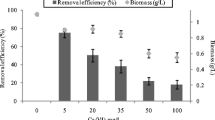Abstract
In recent years, more and more attentions are put on the remediation of Cr(VI) contamination with chromate resistant bacteria. Leucobacter sp. CRB1 was a novel chromate reducing bacteria isolated from the soil of chromite ore processing residue (COPR) disposal site in Changsha, China. The objectives of this study were to evaluate the Cr(VI) tolerance of Leucobacter sp. CRB1 as well as its tolerant mechanism, and Cr(VI) reduction ability. The results showed that Leucobacter sp. CRB1 was able to tolerate 4,000 mg/l of hexavalent chromium with 34.5% reduction efficiency. At the optimum pH 9.0, the maximum concentration of chromate be reduced completely was 1,818 mg/l in growing cells and 2,100 mg/l in resting cells. Scanning electron microscopy (SEM) and energy dispersive X-ray analysis (EDAX) showed that extracellular Cr(VI) reduction of Leucobacter sp. CRB1 contributed to its high tolerance and high reduction ability. With repeating spiking, 2,490 mg/l hexavalent chromium was reduced totally within 17 h. The results suggest Leucobacter sp. CRB1 has potential application for remediation of high concentration of Cr(VI) contamination.






Similar content being viewed by others
References
Bartlett RJ (1991) Chromium cycling in soils and water: links, gaps, and methods. Environ Health Perspect 92:17–24
Carlos G, Itziar A, Maria JL, Serra JL (1998) Aerobic chromate reduction by Bacillus subtilis. Biodegradation 9:133–141
Cervantes C, Ohtake H, Chu L (1990) Cloning, nucleotide sequence, and expression of the chromate resistance determinant of Pseudomonas aeruginosa plasmid pUM505. J Bacteriol 172:287–291
Dermoua E, Velissariou A, Xenos D, Vayenas DV (2005) Biological chromium(VI) reduction using a trickling filter. J Hazard Mater 126:78–85
Eary LE, Rai D (1988) Chromate removal from aqueous wastes by reduction with ferrous iron. Environ Sci Technol 22:972–977
Gibb HJ, Lee PS, Pinsky PF (2000) Lung cancer among workers in chromium chemical production. Am J In Med 38:115–126
Guha H, Jayachandran K, Maurrasse F (2001) Kinetics of chromium(VI) reduction by a type strain Shewanella alga under different growth conditions. Environ Pollut 115:209–218
Hillol G, Krishnaswamy J, Florentin M (2003) Microbiological reduction of chromium(VI) in presence of pyrolusite-coated sand by Shewanella alga Simidu ATCC 55627 in laboratory column experiments. Chemosphere 52:175–183
Jeyasingh J, Ligy P (2005) Bioremediation of chromium contaminated soil: optimization of operating parameters under laboratory conditions. J Hazard Mater 118:113–120
Marisa V, Gustavo C, Edgardo D (2003) A combined bacterial process for the reduction and immobilization of chromium. Int Biodeter Biodegr 52:31–34
Mclean J, Beveridge TJ (2001) Chromate reduction by a Pseudomonad isolated from a site contaminated with chromated copper arsenate. Appl Environ Microbiol 67:1076–1084
Morais PV, Francisco R, Branco R, Chung AP, Costa MS (2004) Leucobacter chromiireducens sp. nov, and Leucobacter aridicollis sp. nov., tow new species isolated from a chromium contaminated environment. Syst Appl Microbiol 27:646–652
Ohtake H, Fujii E, Toda K (1990) Reduction of toxic chromate in an industrial effluent by use of a chromate-reducing strain of Enterobacter cloacae. Environ Technol 11:663–668
Pattanapipitpaisal P, Brown NL, Macaskie LE (2001) Chromate reduction and 16S rRNA identification of bacteria isolated from a Cr(VI)-contaminated site. Appl Microbiol Biotechnol 57:257–261
Petrilli FL, De FS (1977) Toxicity and mutagenicity of hexavalent chromium on Salmonella typhimurium. Appl Environ Microbol 33:805–809
Philip L, Iyengar L, Venkobachar C (1998) Cr(VI) reuction by bacillus coagulans isolated from contaiminated soils. J Environ Eng 124:1165–1170
Rai D, Sass BM, Moore DA (1987) Chromium(III) hydrolysis constants and solubility of chromium(III) hydroxide. Inorg Chem 26:345–349
Romanenko VI, Korenkov VN (1977) A pure culture of bacteria utilizing chromates and bichromates as hydrogen acceptors in growth under anaerobic conditions. Mikrobiologiya 46:414–417
Shen H, Wang YT (1993) Characterization of enzymatic reduction of hexavalent chromium by Escherichia coli ATCC 33456. Appl Environ Microbiol 59:3771–3777
Shen H, Wang YT (1995) Hexavalent chromium removal in two-stage bioreactor system. J Environ Eng 121:798–803
Urvashi T, Datta M (2005) Reduction of toxic chromium and partial localization of chromium reductase activity in bacterial isolate DM1. World J Microbiol Biotechnol 21:891–899
Wang PC, Mori T, Komori K, Sasatsu M, Toda K, Ohtake H (1989) Isolation and characterization of an Enterobacter cloacae strain that reduces hexavalent chromium under anaerobic conditions. Appl Environ Microbiol 55:1665–1669
Wang PC, Mori T, Toda K, Ohtake H (1990) Membrane-associated chromate reductase activity from Enterobacter cloacae. J Bacteriol 172:1670–1672
Acknowledgements
The authors acknowledge the financial support of the National Natural Science Foundation of China (No. 20477059), the Doctoral Fellow Foundation, State Education Ministry of China (20040533048), and the National High Technology Research and Development Project (863) (2006AA06Z374).
Author information
Authors and Affiliations
Corresponding author
Rights and permissions
About this article
Cite this article
Zhu, W., Yang, Z., Ma, Z. et al. Reduction of high concentrations of chromate by Leucobacter sp. CRB1 isolated from Changsha, China. World J Microbiol Biotechnol 24, 991–996 (2008). https://doi.org/10.1007/s11274-007-9564-7
Received:
Accepted:
Published:
Issue Date:
DOI: https://doi.org/10.1007/s11274-007-9564-7




